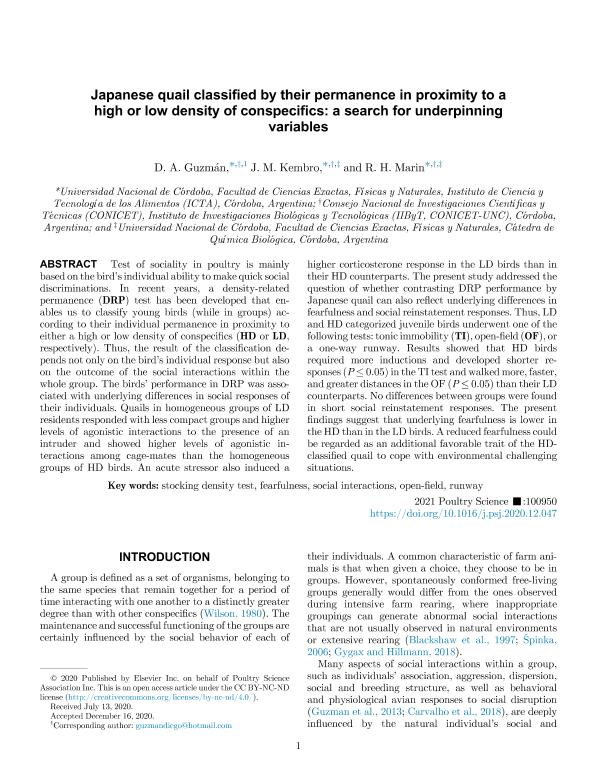Mostrar el registro sencillo del ítem
dc.contributor.author
Guzmán, Diego Alberto

dc.contributor.author
Kembro, Jackelyn Melissa

dc.contributor.author
Marin, Raul Hector

dc.date.available
2021-03-18T15:26:20Z
dc.date.issued
2021-03
dc.identifier.citation
Guzmán, Diego Alberto; Kembro, Jackelyn Melissa; Marin, Raul Hector; Japanese quail classified by their permanence in proximity to a high or low density of conspecifics: a search for underpinning variables; Poultry Science Association; Poultry Science; 100; 3; 3-2021; 1-10; 100950
dc.identifier.issn
0032-5791
dc.identifier.uri
http://hdl.handle.net/11336/128530
dc.description.abstract
Test of sociality in poultry is mainly based on the bird's individual ability to make quick social discriminations. In recent years, a density-related permanence (DRP) test has been developed that enables us to classify young birds (while in groups) according to their individual permanence in proximity to either a high or low density of conspecifics (HD or LD, respectively). Thus, the result of the classification depends not only on the bird's individual response but also on the outcome of the social interactions within the whole group. The birds' performance in DRP was associated with underlying differences in social responses of their individuals. Quails in homogeneous groups of LD residents responded with less compact groups and higher levels of agonistic interactions to the presence of an intruder and showed higher levels of agonistic interactions among cage-mates than the homogeneous groups of HD birds. An acute stressor also induced a higher corticosterone response in the LD birds than in their HD counterparts. The present study addressed the question of whether contrasting DRP performance by Japanese quail can also reflect underlying differences in fearfulness and social reinstatement responses. Thus, LD and HD categorized juvenile birds underwent one of the following tests: tonic immobility (TI), open-field (OF), or a one-way runway. Results showed that HD birds required more inductions and developed shorter responses (P ≤ 0.05) in the TI test and walked more, faster, and greater distances in the OF (P ≤ 0.05) than their LD counterparts. No differences between groups were found in short social reinstatement responses. The present findings suggest that underlying fearfulness is lower in the HD than in the LD birds. A reduced fearfulness could be regarded as an additional favorable trait of the HD-classified quail to cope with environmental challenging situations.
dc.format
application/pdf
dc.language.iso
eng
dc.publisher
Poultry Science Association

dc.rights
info:eu-repo/semantics/openAccess
dc.rights.uri
https://creativecommons.org/licenses/by-nc-nd/2.5/ar/
dc.subject
STOCKING DENSITY TEST
dc.subject
FEARFULNESS
dc.subject
SOCIAL INTERACTIONS
dc.subject
OPEN-FIELD
dc.subject
RUNWAY
dc.subject.classification
Ciencias Veterinarias

dc.subject.classification
Ciencias Veterinarias

dc.subject.classification
CIENCIAS AGRÍCOLAS

dc.subject.classification
Zoología, Ornitología, Entomología, Etología

dc.subject.classification
Ciencias Biológicas

dc.subject.classification
CIENCIAS NATURALES Y EXACTAS

dc.title
Japanese quail classified by their permanence in proximity to a high or low density of conspecifics: a search for underpinning variables
dc.type
info:eu-repo/semantics/article
dc.type
info:ar-repo/semantics/artículo
dc.type
info:eu-repo/semantics/publishedVersion
dc.date.updated
2021-03-12T19:15:10Z
dc.identifier.eissn
1525-3171
dc.journal.volume
100
dc.journal.number
3
dc.journal.pagination
1-10; 100950
dc.journal.pais
Estados Unidos

dc.description.fil
Fil: Guzmán, Diego Alberto. Consejo Nacional de Investigaciones Científicas y Técnicas. Centro Científico Tecnológico Conicet - Córdoba. Instituto de Investigaciones Biológicas y Tecnológicas. Universidad Nacional de Córdoba. Facultad de Ciencias Exactas, Físicas y Naturales. Instituto de Investigaciones Biológicas y Tecnológicas; Argentina. Universidad Nacional de Córdoba. Facultad de Ciencias Exactas Físicas y Naturales. Instituto de Ciencias y Tecnología de los Alimentos; Argentina
dc.description.fil
Fil: Kembro, Jackelyn Melissa. Consejo Nacional de Investigaciones Científicas y Técnicas. Centro Científico Tecnológico Conicet - Córdoba. Instituto de Investigaciones Biológicas y Tecnológicas. Universidad Nacional de Córdoba. Facultad de Ciencias Exactas, Físicas y Naturales. Instituto de Investigaciones Biológicas y Tecnológicas; Argentina. Universidad Nacional de Córdoba. Facultad de Ciencias Exactas Físicas y Naturales. Instituto de Ciencias y Tecnología de los Alimentos; Argentina
dc.description.fil
Fil: Marin, Raul Hector. Consejo Nacional de Investigaciones Científicas y Técnicas. Centro Científico Tecnológico Conicet - Córdoba. Instituto de Investigaciones Biológicas y Tecnológicas. Universidad Nacional de Córdoba. Facultad de Ciencias Exactas, Físicas y Naturales. Instituto de Investigaciones Biológicas y Tecnológicas; Argentina. Universidad Nacional de Córdoba. Facultad de Ciencias Exactas Físicas y Naturales. Instituto de Ciencias y Tecnología de los Alimentos; Argentina
dc.journal.title
Poultry Science

dc.relation.alternativeid
info:eu-repo/semantics/altIdentifier/url/https://www.sciencedirect.com/science/article/pii/S0032579120310014
dc.relation.alternativeid
info:eu-repo/semantics/altIdentifier/doi/http://dx.doi.org/10.1016/j.psj.2020.12.047
Archivos asociados
